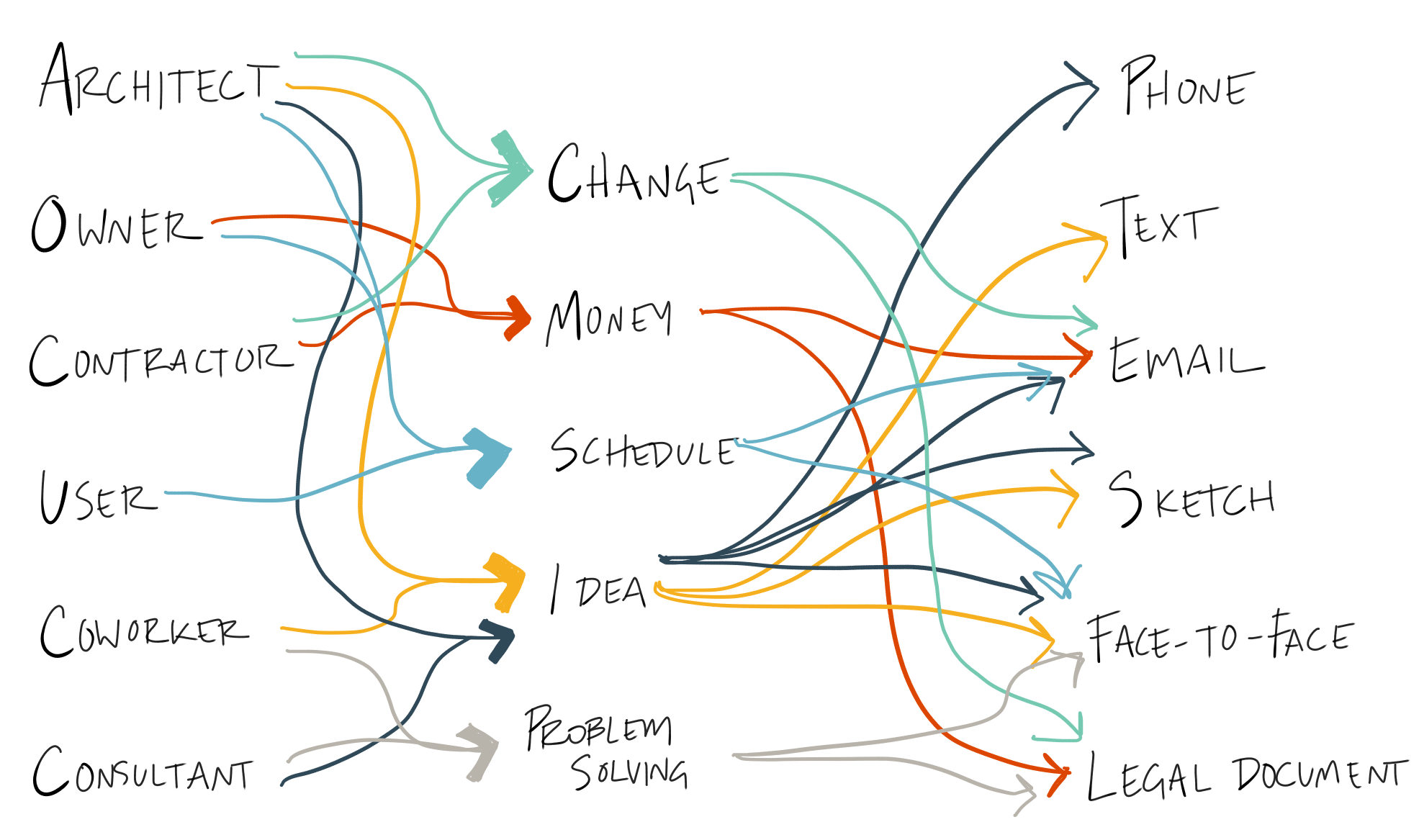Types of communication in architecture
Hand-written, text on a phone, email, contract language, sketch, face-to-face, over-the-phone, construction drawings….all of these things are types of communication that can be implemented in an architecture project. And on any given project you could have owners, user groups, project managers, owners reps, contractors, developers, lawyers, coworkers, bosses, construction managers, product reps, building officials, etc. All of these options and players could leave you sitting, rocking in a corner, shouting
Note: This is the thirty-sixth post in a group series called #ArchiTalks. This month’s topic is “Communication.”
Communicating is something we frequently take for granted, both in our miraculous ability to use words to create ideas – stop and think about that for a second, it’s insane! Debbie Millman recently interviewed Steven Pinker and what ensued was a conversation that makes you appreciate all the ways we interact and our types of communication.
We also tend to have a bad habit of assuming that every person we communicate with understands the words we use or the ideas we have. The general idea of “archispeak” plays into this heavily, but each person does it because we communicate from our specific position in the world.
The biggest things to understand when it comes to the types of communication available and picking the correct one for the situation are:
- The piece of information you are trying to convey
- The relationship to the person you’re communicating with
Each scenario will create a different outcome and preferred/best method among the types of communication available.
- A teaching moment with an intern or peer who wants to learn about a flashing detail, for instance, will likely best be communicated face-to-face through a sketch and supporting conversation.
- An answer to a contractor that involves project cost is likely best communicated over email for a written record of the conversation.
- A detail for a drawing set that needs to be coordinated can likely be worked through over the phone, but you might need to share sketches or do a virtual meeting and share screens to ensure both parties are on the same page.
- The drawings created by an architect are in and of themselves a part of the contract and communicate the project through visuals and annotations.
Knowing the types of communication and the players involved is only half the battle in communicating for a successful architecture project. Another important piece to remember is that the types of communication will change over time. We didn’t have virtual screen sharing or text messaging and email 30 years ago, and it will likely look different 30 years from now. In the same way, the people we interact with on projects will likely look different 30 years from now. This means that the understanding of the information and your relationship with the other party become even more important.

As you can see, the options are limitless in the ways an architect can interact with others on the project team, using various types of communication to solve problems and deliver a great project. Those two things – problem-solving and project delivery quality – boil down to one thing: RESPECT.
Take it from Aretha, you don’t get very far without respect. Mis-using a type of communication can damage a project or working relationship. You have to respect the other person’s time, their role on the project, and them inherently as a person. Just because I can text my contractor performing the #L2HQ master bathroom work and we can take pictures of sketches and text through design details, sometimes using emojis or GIFs…does not mean I can do that with the contractor on a commercial project.
Within each of the types of communication, you also need to treat the person you’re interacting with respectfully. Just as it’s not respectful for me to text a coworker late at night, even if to solve a problem, it’s not respectful for a contractor to call me “Girl” in the title of an email. You have to understand and respect the working relationship or it won’t matter what type of communication you use – it won’t be productive.
A healthy dose of respect in your working relationship on a project combined with the correct use of the different types of communication as needed through the lifespan of a project will help significantly in the creation of a quality project.

Yes, design skill, money, etc also play a part. But never underestimate proper, respectful communication.
Respectfully,
To see the take on “Communication” from other Architects, follow the links to the others in the #ArchiTalks group who are posting today on the theme:
- James Mehaffey – Yeoman Architect (@jamesmehaffey) “Communication in a Yada Yada World”
- Eric Faulkner – Rock Talk (@wishingrockhome) “Talk, Write, Draw — A Com Hat Trick”
- Michele Grace Hottel – Michele Grace Hottel, Architect (@mghottel) “Architalks 36: Communication”
- Jeffrey Pelletier – Board & Vellum (@boardandvellum) “Tips for Communicating with Your Architect, Interior Designer, or Landscape Architect”
- Lee Calisti – Think Architect (@LeeCalisti) “what does it communicate?”
- Brian Paletz – The Emerging Architect (@bpaletz) “Communication – What, How, Why?”
- Meghana Joshi – IRA Consultants, LLC (@MeghanaIRA) “Architalks #36: Project Amplify”
- Keith Palma – Architect’s Trace (@cogitatedesign) “Who’s Bad!”
- Mark Stephens – Mark Stephens Architects (@architectmark) “Communication”
- Jeff Echols – Architect of the Internet (@Jeff_Echols) “Communication and the Question of Relevance”
- Samantha R Markham – The Aspiring Architect (@TheAspiringArch) “Why Communication Skills are a Must for Aspiring Architects”
- Jane Vorbrodt – Kuno Architecture (@janevorbrodt) “Explain Yourself…”




